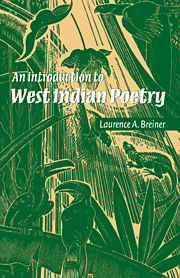Book contents
- Frontmatter
- Contents
- Preface
- Chronology for Anglophone Caribbean poetry
- Map of the Caribbean
- 1 West Indian poetry and its audience
- 2 The Caribbean neighborhood
- 3 Overview of West Indian literary histories
- 4 The relation to “Europe”
- 5 The relation to “Africa”
- 6 The relation to “America”
- Notes
- Guide to further reading
- Index
2 - The Caribbean neighborhood
Published online by Cambridge University Press: 06 January 2010
- Frontmatter
- Contents
- Preface
- Chronology for Anglophone Caribbean poetry
- Map of the Caribbean
- 1 West Indian poetry and its audience
- 2 The Caribbean neighborhood
- 3 Overview of West Indian literary histories
- 4 The relation to “Europe”
- 5 The relation to “Africa”
- 6 The relation to “America”
- Notes
- Guide to further reading
- Index
Summary
A self-consciously West Indian poetry develops against the background of cultural awakenings occurring throughout the Caribbean during this century; like colonialism itself, this is one of the shared experiences of nations sharply isolated from one another as much by history as by geography. Literary self-consciousness unfolds at different times in different islands, but while even territories that spoke the same language (such as Haiti and Martinique) were often barely in communication with one another until quite recently, common external pressures induced sometimes strikingly parallel – though not simultaneous – patterns of cultural development across the board.
In 1912 the Panama Canal was completed; in 1914 war broke out in Europe. The first of these events strengthened political, military, and economic ties between the United States and the Caribbean as a whole; the second weakened ties with Europe. Both events had a profound impact directly on the people of the region, since many of them served as workers in the one venture or as troops in the other, and returned home transformed by the experience. Both contributed as well to the momentum of emerging nationalism, for which world events of the 1930s and 1940s would provide the final catalyst. Equally significant for the Caribbean, in the long run, was the transformation wrought by war on the metropolitan cultures themselves, on Europe and North America. When World War I was over, the “modern world” had begun, and an inspired generation survived the Jazz Age and the Depression until World War II ushered in the post-modern period. In those years between the wars, the West seemed to have two cultural capitals: Paris and New York.
- Type
- Chapter
- Information
- An Introduction to West Indian Poetry , pp. 25 - 58Publisher: Cambridge University PressPrint publication year: 1998



